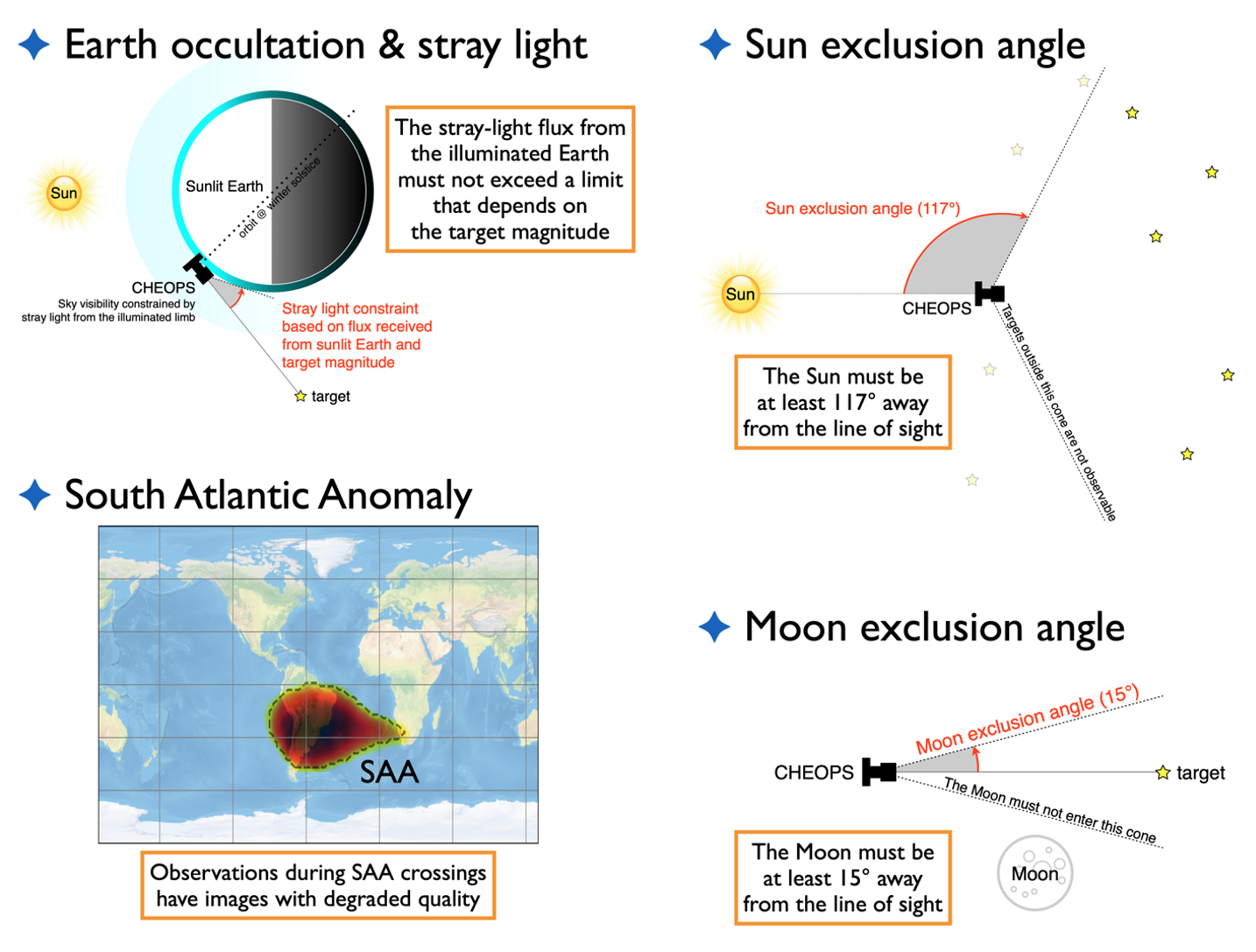Sky Visibility - CHEOPS
Sky Visibility
The regions of the sky that CHEOPS can observe at any given time are determined by a combination of factors. These include hard constraints, which ensure the safety of the spacecraft and its payload, and soft constraints, which aim to keep contributions to the noise budget from stray light within acceptable limits. Observations will be restricted in certain directions due to the positions of the Sun, Moon, or the illuminated Earth relative to CHEOPS. Additionally, there may be interruptions during parts of the spacecraft's orbit caused by the Earth occulting the Line of Sight (LoS) to the target, or by excess radiation-induced noise when passing through the South Atlantic Anomaly.
Depending on the scientific goals of an observation, it may be necessary to achieve a specific sensitivity or signal-to-noise ratio and to observe a minimum portion of a transit. Detecting a transit can be done by observing part of it or at low efficiency, but determining the transit's shape, ingress, and egress requires longer visibility and high efficiency.
The CHEOPS pointing constraints are illustrated here:

Figure 1: CHEOPS Pointing Constraints. (a) Left upper panel: The minimum angle allowed between the LoS and any visible part of the illuminated Earth limb shall be 35°. This angle is referred to as the stray light exclusion angle. In practice, a cap on the contribution from Earth stray light to the CHEOPS noise budget translates to a minimum angle of around 25° – soft constraint. (b) Right upper panel: During observations, the Sun must be outside a cone around the line-of-sight (LoS) of the telescope with a half-angle of 117° (previously 120°) – hard constraint. (c) Left lower panel: The South Atlantic Anomaly (SAA) as observed by ROSAT (Low Earth Orbit, altitude 580 km). For observations to be valid, the maximum energetic particle flux at the detector due to the spacecraft's passage through the SAA shall be 2 particles/s/cm² – soft constraint. (d) Right lower panel: The bright Moon must not be within a cone around the LoS of the telescope with a half-angle of 15° – soft constraint. In addition to the constraints noted above, the target must have a projected altitude from the surface of the Earth equal to or higher than 100 km.
Simulations Before Launch
Before launch, the CHEOPS sky coverage was simulated based on the following assumptions:
- The Earth shall be a perfect sphere with an albedo of 1.
- The spacecraft's orbit shall have a local transit of the ascending node (LTAN) at 6 am, an altitude of 700 km, and covers the year 2018.
- No data shall be taken during passages through the South Atlantic Anomaly (position and extent derived using the ESA Spenvis tool) or Earth occultations.
- The angle between the Sun and the pointing direction/LoS shall always be greater than 117° to protect the instrument radiators from solar illumination (Figure 1b).
- The angle between the Moon and the pointing direction shall always exceed 15° (Figure 1d).
- The point source transmission (rejection) of the telescope/payload shall be based on:
- A micro-roughness of 10 Angstroms for the primary mirror (M1) and 5 Angstroms for the secondary mirrors (M2, M3) and the backend optics.
- A particulate contamination level of 300 ppm.
- Textbook values for the high emissivity/absorptance coatings used on the telescope baffles (internal, external primary and secondary), the backend optics mounting structure, M2 spider, and the M1 mirror border.
- 99.6% of the Earth stray light contribution can be subtracted from CHEOPS images during on-ground post-processing.
For these simulations, the constraint on the Earth stray light exclusion angle (> 35°) was replaced with a limit on the contribution of Earth stray light to the overall noise budget. Due to the high level of stray light rejection by the telescope baffle, the angle between the LoS and the illuminated Earth can be as low as 25°. The constraint on the Moon-pointing direction was also removed.
These simulations are detailed in Kuntzer et al., 2014, and in a presentation at the CHEOPS Science Workshop #4. The results are shown in Figure 2. The plots indicate, for each sky position, the cumulative number of days per year that meet the pointing constraints and have a stray light contribution to the noise budget of ≤ 5 ppm for V=9, G-type stars (Teff=5500K) or ≤ 70 ppm for V=12, K-type stars (Teff=4500K). The fraction of each spacecraft orbit free from interruptions due to the SAA and Earth occultation is 50%.

Figure 2: Plot, as a function of pointing direction, of the cumulative number of days for which the contribution from Earth stray light to the noise budget is ≤ 5 ppm /70 ppm for a V=9 G-type (Teff=5500K)/ V=12 K-type (Teff=4500K), and for which the maximum % of each spacecraft orbit that is free from interruptions due to Earth Occultation or passage through the South Atlantic Anomaly is 50%. The sinusoidal trajectory marks the locus of the Sun. Plots courtesy of Thibault Kuntzer (EPFL, CH) and Andrea Fortier (UBE, CH).

Figure 3: The instantaneous sky coverage for all calendar months where pointing constraints are met and the stray light contribution is ≤ 5 ppm for V=9 G-type stars (Teff=5500K) or ≤ 70 ppm for V=12 K-type stars (Teff=4500K). Additionally, 50% of spacecraft orbits are free from interruptions. Note that while these calculations are based on the year 2018, they are applicable for every year.
Curious to learn more?
Further details on the CHEOPS payload can be found at CHEOPS Consortium Mission website (http://cheops.unibe.ch) and in the references at this link.
References
SPENVIS website: https://www.spenvis.oma.be/models.php
- Removed a total of (4) style text-align:center;
This website was last updated on 25 March 2025.








































 Sign in
Sign in
 Science & Technology
Science & Technology